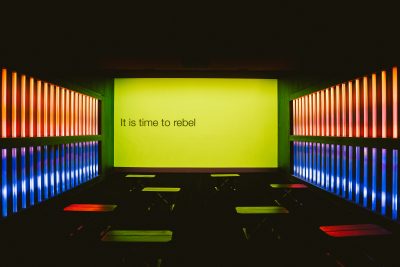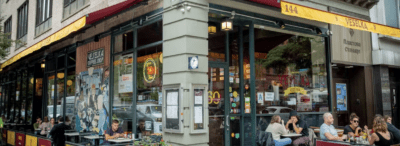Jeffrey Wright, center, as General Gibson in 'Asteroid City' (Courtesy of Pop. 87 Productions/Focus Features)
Meet the team that makes Wes Anderson movies look like Wes Anderson movies
Producer Jeremy Dawson, set designer Adam Stockhausen and collaborator Jake Perlin take us behind the scenes of ‘Asteroid City’
Wes Anderson’s style is relentlessly mimicked, memed, mocked and marveled at, but it’s impossible to fully replicate. The recent wave of fan-made odes to Anderson have circulated online since last spring, much to the director’s chagrin, and his newest movie “Asteroid City” is only adding fuel to the idea that his work can be easily copied.
But who makes Anderson’s cinematic confections what they are? A couple of Brooklynites, naturally. Jeremy Dawson is Anderson’s long-time producer, Adam Stockhausen is his Oscar-winning production designer (for “The Grand Budapest Hotel”), and the director’s friend Jake Perlin, who distributes movies through his company The Film Desk and co-edited a book with Anderson about “Asteroid City” called “Do Not Detonate Without Presidential Approval.”
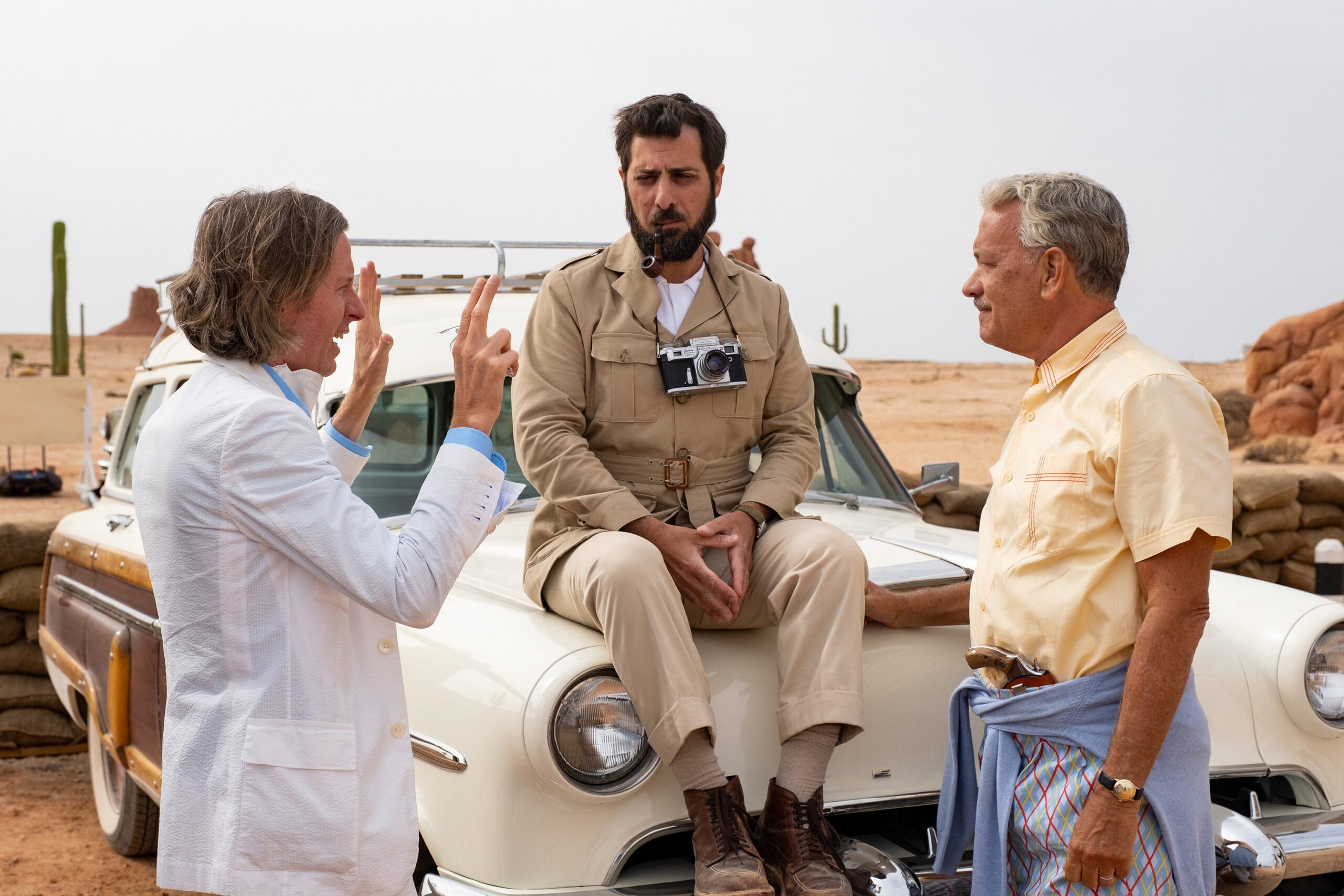
From left: Anderson, Schwartzman and Tom Hanks on the set of ‘Asteroid City’ (Courtesy of Roger Do Minh/Pop. 87 Productions/Focus Features)
We assembled the trio to discuss how they created the world of “Asteroid City” with Anderson.
“Asteroid City” follows war photographer Augie Steenbeck — played by longtime Anderson collaborator Jason Schwartzman — and his struggle to tell his four children that their mother has died while the family is on the road to a science convention. When an alien pays a visit during the gathering, conventioneers and fellow travelers are stunned out of their various stupors.
Dawson and Stockhausen share with Brooklyn Magazine how they made “Asteroid City” in the desert of Chinchón, Spain, during the pandemic in 2021. Perlin explains how his book came to be, with insightful guest perspectives on the movies that inspired Anderson, all sewn together with an interview between Perlin and the director.
This interview has been lightly edited for clarity and concision.
What’s it like to produce a Wes Anderson movie?
Jeremy Dawson: As a director, Wes is the kind of guy who’s very confident in his creative and practical decisions. Whatever kind of direction he goes, he commits to it and we figure it out. So producing for Wes means there’s always a lot of problem solving. We always joke that we’re making student films at a very large scale. What we mean from that is the attitude of not being stuck doing things the way they’re usually done, in some system that we’ve learned. We’re not afraid to take risks or try something that seems crazy. We figure it out.
“Asteroid City” is about an encounter with an alien that spurs fear and paranoia, but it also brings many of the characters closer. How do you relate to the story?
Jake Perlin: I was totally moved by the film the first time I saw it. I’m usually moved by Wes’s films. For instance, I felt a cultural connection in “The Grand Budapest Hotel” to Eastern European Jews and a version of the old world torn away. In “Asteroid City,” it was really direct. I’m a new father. All the stuff with Jason Schwartzman’s character and his children, particularly the little girls, I found incredibly moving. I don’t know if Wes wrote the story because he’s become a father, but it really spoke to me.
I have a son and nothing would be more fun than taking him to a Junior Astronomers Convention. I just love the clumsy parenting aspect of it. Wes was able to tap into these things. You don’t ever feel manipulated by the emotions, but somehow, there’s always a bit of a pang.
Dawson: I agree, Wes doesn’t have a tendency to overplay emotion or humor. He doesn’t want to milk things, but this one has a lot of layers of existential querying going in every direction.
Jeremy and Adam, were you doing pre-production for “Asteroid City” from home in Brooklyn during the pandemic?
Dawson: Pandemic aside, we’ve always worked a lot by email because we have a very international crew. From a production standpoint, it’s smarter to not relocate everybody until you need to. Often we have satellite scouts find our locations and then we figure out how to shoot it over email. In January of 2021, we made our first visit to the location in Chinchón, Spain, but we already knew what we were planning to do by that time.
Adam Stockhausen: There isn’t an in-person component to the production as things ramp up and “Asteroid City” didn’t until much, much later. When we visited in ‘21, we were about to build the set at that point. We had really done a huge amount of planning about what “Asteroid City” was going to be and how it was all going to work. It was essentially all laid out at that point. But prep for this one was funny, because sometimes you’re sitting there on Zoom with somebody who’s three blocks away. It was very strange.
The circumstances also led to us create a virtual tool set. We did a lot more computer-based modeling than we would normally do. Normally, we try to get down to the cardboard and glue and scissors mode as quickly as possible, and this one was much more developed in 3D computer programming.
Dawson: After working in so many different countries over the years, we’ve added people to the team from all over the world. If we have a great illustrator in England or a graphic designer from France, working remotely allows us to keep the band together, even if we’re not working in their native country the next time. It’s cool how we roll around like a snowball, just like picking up creative people into this bigger team.
Wes’s cinematographer Robert Yeoman told me the worst thing you can say to Wes is, “That’s how we always do it.” So despite changing up his work methods, why do you think the some of the public think his movies alway look the same?
Dawson: I think it’s just because that’s an easy answer. We all feel it’s a pretty surface-level distillation of the movies. Wes is very knowledgeable about film, culture and history, so there’s many layers, both in the text, but also in terms of the visuals and the references and where all of these things all come from. It’s all much more complex than most people are talking about on TikTok. But that being said, Wes is doing his thing, he doesn’t even think of it as a style. He’s just doing the thing that he thinks works for the moment in a kind of fearless way. Imitation is a form of flattery or admiration, even if it’s not really scratching the surface.
Jake, how did your book with Wes originate?
Perlin: Wes does books with Matt Zoller Seitz for each film; these big, beautiful coffee table books called the Wes Anderson Collection. Wes initially approached me about writing a piece for that book. He had a couple of writers in mind and some specific films. But through more conversations and our shared enthusiasm, we came to this book. I also felt more pressure to write an individual piece. To me, it would be harder to write a 2,000-word piece than edit a 250-page book. So this was like my way out of that responsibility. [Laughs.]
Did you or Wes decide which photo and movie movie references to include in the book?
Perlin: Wes invited me to a screening of the film quite a long time ago. We didn’t talk about influences ahead of the screening, and I emailed Wes after, saying, “This reminds me of the photographer Eve Arnold. This reminds me of James Dean. This reminds me of Paul Newman and images that I’ve seen of The Actor’s Studio.” When I talked to Wes about it, it all checked out, so I included it.
Instead of being a collection of essays about “Asteroid City,” the book is a series of essays about the movies that inspired it. Why did you go that route?
Perlin: Many of the contributing writers wouldn’t have had a chance to see the film last year, so Wes had the idea that their pieces should be standalone criticism. It allows a journalist or writer to make a deeply informed piece and then the connections to “Asteroid City” reveal themselves from there. But we have these amazing pieces about films that exist separate from “Asteroid City.” I hope the book works both as something that can give people a bit of a lead-in to the movie but also resonates more after they see it.
Wes is also just sharing his enthusiasms in a non-pretentious way. He just loves Sam Shepard, and he wanted Shepard’s story called “Wild to the Wild” from the collection “Cruising Paradise” in the book. It turned me on to Sam Shepard because I’ve seen his plays, but I’ve never read the short stories. So the book also operates as Wes connecting people to his favorite works.
Jeremy and Adam, many of the movies that inspired “Asteroid City” are based in Death Valley and Mojave Desert, so why did you shoot the movie in Spain?
Dawson: From a producing standpoint, if you go into the best places in the Mojave Desert or Death Valley, you’re probably very far away from any infrastructure you might need, including a place to stay. [Laughs.] We didn’t want to spend hours commuting in 150 degree heat and everything. Especially considering that this was an imagined place within a play come to life, I think there was also some benefit to creating our own universe. And to that end, we’ve had really good experiences working in in Europe, and we arrived at Spain through a bunch of practical considerations including the weather and the flatness of the terrain. But could we have shot this somewhere in the American West? Probably, but it would have been a different thing. I think it’s better that we created it from scratch because it makes our movies unique.
For example, we shot a scene in a garlic warehouse because we needed space to build some sets, but it still had thousands of crates of fresh garlic in the back. That gives the moviemaking experience a sense memory. How we make our movies leaks into the adventures you see on screen.
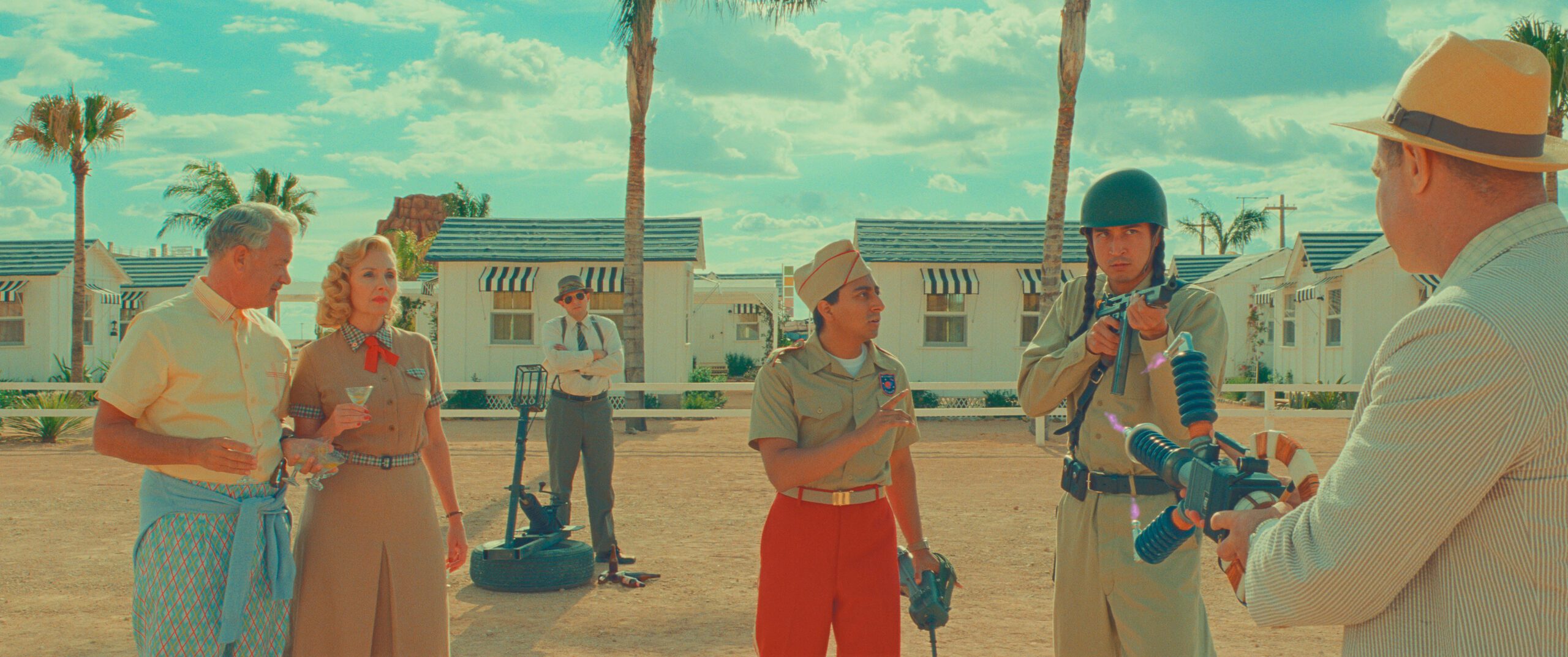

From left: Tom Hanks as Stanley Zak, Hope Davis as Sandy Borden, Tony Revolori as Aide- de-Camp, and Liev Schreiber as J.J. Kellogg (Courtesy of Pop. 87 Productions/Focus Features)
Do you archive or reuse pieces you create?
Stockhausen: We do try to keep pieces that are small enough to be archivable. Sometimes things are built on such a scale that you just simply can’t save them. I would say we try to recycle stuff internally in the movies as much as we can for efficiency, speed and sustainability. In “The French Dispatch,” we made this floor with really intricately painted, layer-upon-layer floorboards. They were challenging to make because they had to be smooth enough to roll the dolly on without going “boom, boom,” and yet they had to look really rich and old. We used them in like every single scene in the movie. We moved them from set to set and reconfigured them. Sometimes they were walls, sometimes they were floorboards. So things do fall into becoming other things, and then pieces of it we save for later on.
Was anything saved from the Belafonte, the ship in “The Life Aquatic with Steve Zissou?”
Dawson: The actual boat that was out on the water was resold afterwards. But the set of the ship’s interior, I’m pretty sure it was pulled out of Stage Five at Cinecittà Studios and put in the scrap heap.
Stockhausen: There are a couple of scale models of the Belafonte still around. Wes has one. We keep chunks of things. There’s the 180 Studios exhibition in London right now, where a lot of the original pieces from “Asteroid City” are actually set up. The luncheonette, the vending machines, one of the cabins. Wes archives a lot of the pieces that are small enough, but sometimes things are built at such a scale that they can’t be saved.
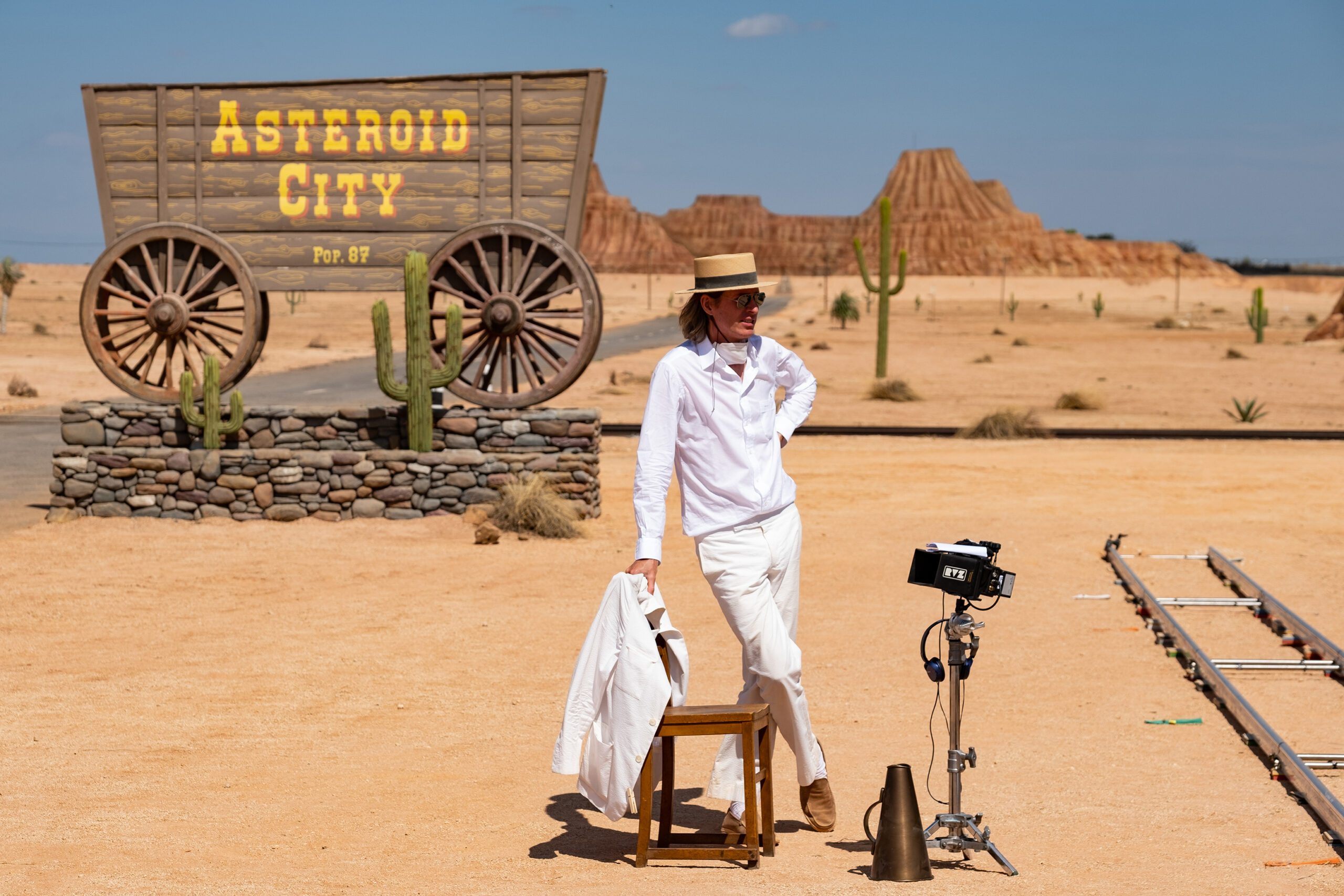

The auteur on set (Courtesy of Roger Do Minh/Pop. 87 Productions/Focus Features)
You might also like 


















